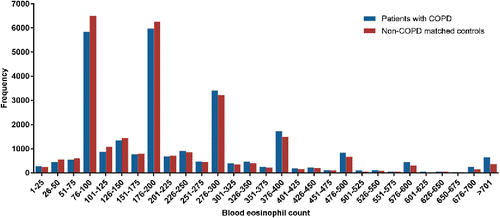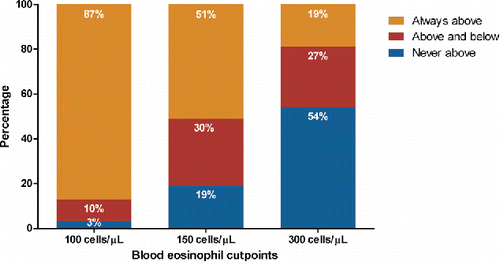Figures & data
Table 1. Demographic and clinical characteristics for COPD patients and non-COPD matched controls (matched on age, sex and smoking status).
Figure 1. Histogram of blood eosinophil counts (cells/μL) for COPD patients and non-COPD controls in the UK Clinical Practice Research Datalink. Histogram based on absolute (untransformed) values. Note: Only the first blood eosinophil count was used in this analysis. COPD, chronic obstructive pulmonary disease.

Table 2. Mean blood eosinophil counts (cells/μL) among COPD patients by demographic and disease characteristics.
Figure 2. Proportion of blood eosinophil counts “always above”, “fluctuating above and below”, or “never above” cut points of 100, 150, and 300 cells/μL among COPD patients at least two blood eosinophil measurements during follow up (n = 13,463). “Always above” defined as all blood eosinophil counts being greater than or equal to the cut point, “fluctuating above and below” defined as at least one blood eosinophil count less than and at least one blood eosinophil count greater than or equal to the cut point, while “never above” defined as being always less than the cut point.

Figure 3. Proportion of blood eosinophil counts “always above”, “fluctuating above and below”, or “never above” cut points of 100, 150, and 300 cells/μL, among COPD patients at least two blood eosinophil measurements during follow up (n = 13,463), stratified by asthma diagnosis.**Asthma diagnosis defined as at least two asthma medical codes (anytime during the patient's history prior to the index date). “Always above” defined as all blood eosinophil counts being greater than or equal to the cut point, “fluctuating above and below” defined as at least one blood eosinophil count less than and at least one blood eosinophil count greater than or equal to the cut point, while “never above” defined as being always less than the cut point.

Table 3. Characteristics of COPD patients with blood eosinophil counts “always above”, “fluctuating above and below”, and “never above” 100, 150, and 300 cells/µL among patients at least two blood eosinophil measurements during follow up (n = 13,463).
